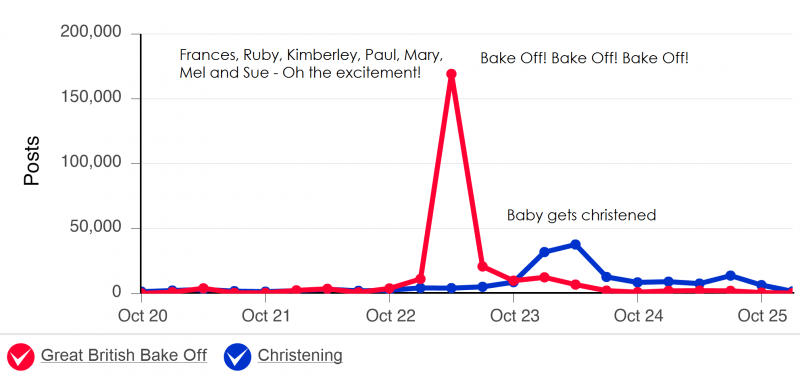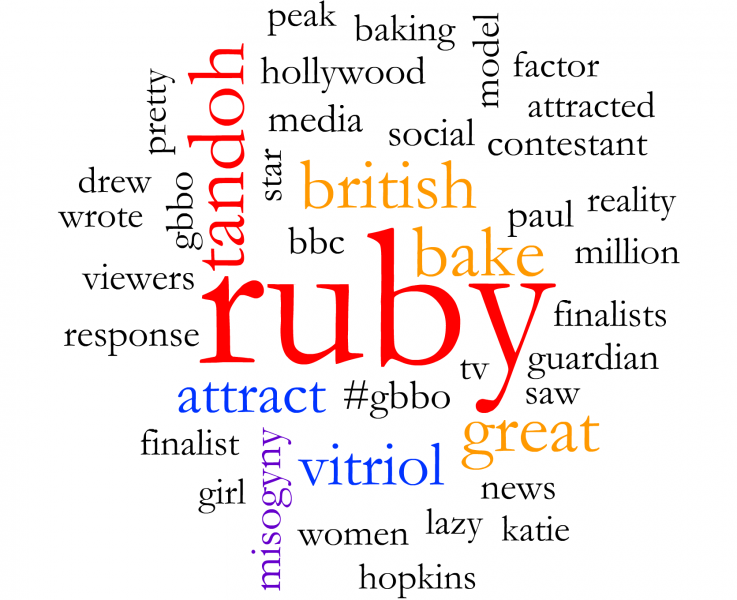The Week on the Web: Battle of Britain
This week saw two equally important events take place – a popular reality TV programme aired its finale and a popular prince got christened. Both The Great British Bake Off and the royal family are an institution in the country, adored and criticised in equal measure for a variety of reasons.
While the royal family may have a more traditional kind of fame, it hasn’t mastered social engagement in the way that the Bake Off (as those in the know affectionately refer to it) has. We know that 40% of peak-time Twitter traffic is watching television, which is reflected in the amount of mentions #GBBO received on Tuesday during the tense final. As the graph shows, Prince George’s low-key christening barely made a ripple on social media, considering the excitement before and after his birth was tantamount to global hysteria. Some newspapers chose to reflect the popularity of the even in their coverage, as Benedict Brogan highlighted:
As the graph shows, Prince George’s low-key christening barely made a ripple on social media, considering the excitement before and after his birth was tantamount to global hysteria. Some newspapers chose to reflect the popularity of the even in their coverage, as Benedict Brogan highlighted:
Just like the old days, this. The Independent’s royal christening coverage in full: nib at bottom of p27 pic.twitter.com/XH7kZczmiD
— Benedict Brogan (@benedictbrogan) October 24, 2013
Though what is not so clear from this one graph is the spread of conversation. Whereas the Bake Off received two thirds of its week’s mentions around the final episode, ‘Prince George’ mentions have been throughout the week, possible suggesting there is more to say on the topic.
That said, the Bake Off is increasing in popularity, the latest finale reportedly watched by a peak audience of 9.1 million making it the most popular BBC Two programme in a decade. It has also been announced that the show will move to BBC One for its fifth series next year.
The reality smash hit also gained attention outside of the actual broadcast, initially when contestant Ruby Tandoh and judge Paul Hollywood had a Twitter row with Chef Raymond Blanc, and then after the final episode when Ruby wrote an article on the Guardian’s Comment is free, titled: ‘The Great British Bake Off: why did our show attract so much vitriol?’.
This article has been shared on Facebook over 26,000 times and just over 9,000 times on Twitter (Google+ had 119 shares, Pinterest 16 and LinkedIn 28). Discussing people’s negative attitude towards the show and its contestants, the piece has so far attracted 1379 comments.
 Using Cision Social Media to create a conversation cloud, we see that Ruby’s article is forming large parts of the discussion about her, with the words ‘misogyny’ and ‘vitriol’ relating to it, and the ‘guardian’ received a lot of mentions for hosting the article.
Using Cision Social Media to create a conversation cloud, we see that Ruby’s article is forming large parts of the discussion about her, with the words ‘misogyny’ and ‘vitriol’ relating to it, and the ‘guardian’ received a lot of mentions for hosting the article.
‘Hopkins’ appears due to Katie Hopkins’ article in The Sun (which was covered in the Mirror for a paywall-free version), calling Ruby a crybaby.
In a week that had a very British ending and, in many ways, a very British beginning, social media joined in the conversation in two different ways. A television show triumphed over a news item, and a new tradition triumphed over a very old one. The two stories reflect the way that social media is becoming a part of society, always interested in the next big thing but quickly getting bored and moving on.
All graphs made with Cision Social Media via CisionPoint.

Leave a Comment